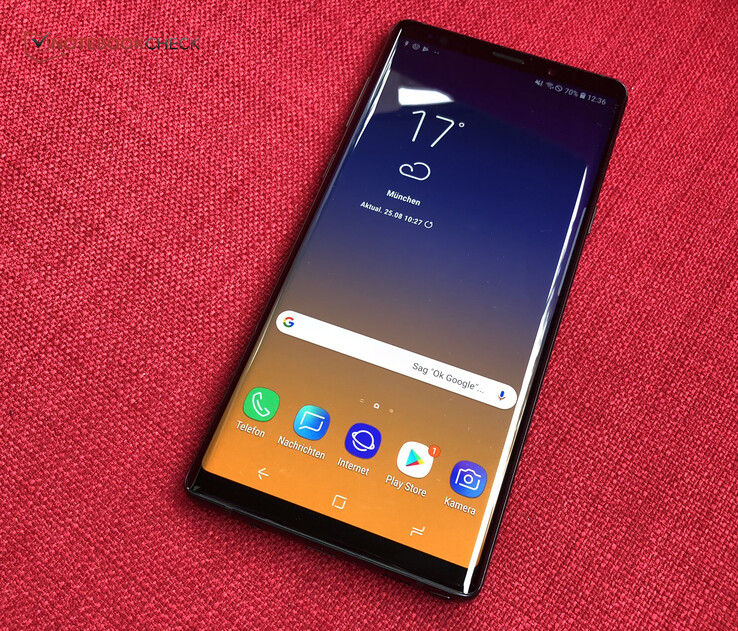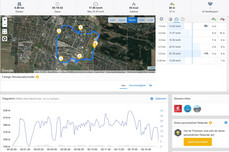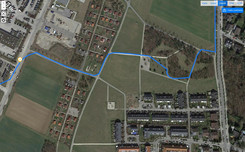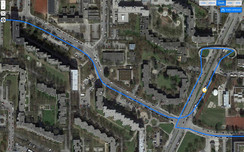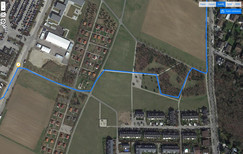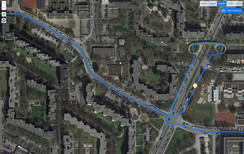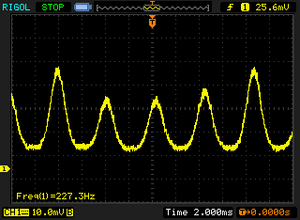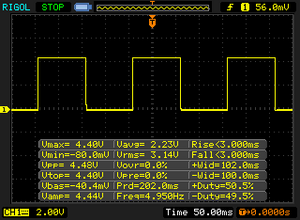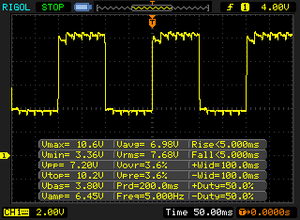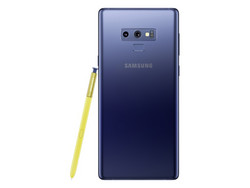Test: Samsung Galaxy Note 9 Smartphone (Sammanfattning)
Topp 10...
» Topp 10: Bästa bärbara allround/multimediadatorerna
» Topp 10: Bästa bärbara speldatorerna
» Topp 10: Bärbara budget/kontorsdatorer
» Topp 10: Bästa bärbara kontors/premiumdatorerna
» Topp 10: Bärbara arbetsstationer
» Topp 10: De bästa små/kompakta bärbara datorerna
» Topp 10: Bästa ultrabooks
» Topp 10: Bästa hybriddatorerna
» Topp 10: Bästa surfplattorna
» Topp 10: Marknadens bästa smartphones
Storleksjämförelse
| |||||||||||||||||||||||||
Distribution av ljusstyrkan: 96 %
Mitt på batteriet: 499 cd/m²
Kontrast: ∞:1 (Svärta: 0 cd/m²)
ΔE ColorChecker Calman: 4.62 | ∀{0.5-29.43 Ø4.78}
ΔE Greyscale Calman: 2.2 | ∀{0.09-98 Ø5}
144.6% sRGB (Calman 2D)
Gamma: 2.103
CCT: 6115 K
| Samsung Galaxy Note 9 Super AMOLED, 2960x1440, 6.4" | Apple iPhone 8 Plus IPS, 1920x1080, 5.5" | HTC U12 Plus Super LCD 6, 2880x1440, 6" | Huawei Mate 10 Pro OLED, 2160x1080, 6" | OnePlus 6 Optic AMOLED, 2280x1080, 6.3" | LG G7 ThinQ IPS, 3120x1440, 6.1" | Samsung Galaxy Note 8 Super AMOLED, 2960x1440, 6.3" | |
|---|---|---|---|---|---|---|---|
| Screen | 30% | 23% | 29% | 10% | 4% | 14% | |
| Brightness middle (cd/m²) | 499 | 559 12% | 395 -21% | 629 26% | 430 -14% | 974 95% | 530 6% |
| Brightness (cd/m²) | 506 | 538 6% | 402 -21% | 636 26% | 437 -14% | 975 93% | 536 6% |
| Brightness Distribution (%) | 96 | 90 -6% | 90 -6% | 94 -2% | 87 -9% | 96 0% | 93 -3% |
| Black Level * (cd/m²) | 0.38 | 0.37 | 0.49 | ||||
| Colorchecker dE 2000 * | 4.62 | 1.3 72% | 1.6 65% | 1.7 63% | 2.3 50% | 5.4 -17% | 2.6 44% |
| Colorchecker dE 2000 max. * | 10.91 | 2.7 75% | 3.4 69% | 3.6 67% | 4.6 58% | 13.1 -20% | 5.1 53% |
| Greyscale dE 2000 * | 2.2 | 1.8 18% | 1.1 50% | 2.4 -9% | 2.4 -9% | 5 -127% | 2.7 -23% |
| Gamma | 2.103 105% | 2.25 98% | 2.14 103% | 2.15 102% | 2.28 96% | 2.31 95% | 2.04 108% |
| CCT | 6115 106% | 6797 96% | 6536 99% | 6337 103% | 6160 106% | 7480 87% | 6206 105% |
| Contrast (:1) | 1471 | 1068 | 1988 |
* ... mindre är bättre
Skärmflimmer / PWM (Puls-Width Modulation)
| Skärmflimmer / PWM upptäckt | 227 Hz | ||
Displayens bakgrundsbelysning flimrar vid 227 Hz (i värsta fall, t.ex. med PWM) . Frekvensen för 227 Hz är relativt låg, så känsliga användare kommer sannolikt att märka flimmer och uppleva ansträngda ögon vid den angivna ljusstyrkeinställningen och nedan. Som jämförelse: 53 % av alla testade enheter använder inte PWM för att dämpa skärmen. Om PWM upptäcktes mättes ett medelvärde av 8111 (minst: 5 - maximum: 343500) Hz. | |||
Visa svarstider
| ↔ Svarstid svart till vitt | ||
|---|---|---|
| 6 ms ... stiga ↗ och falla ↘ kombinerat | ↗ 3 ms stiga | |
| ↘ 3 ms hösten | ||
| Skärmen visar väldigt snabba svarsfrekvenser i våra tester och borde vara mycket väl lämpad för fartfyllt spel. I jämförelse sträcker sig alla testade enheter från 0.1 (minst) till 240 (maximalt) ms. » 17 % av alla enheter är bättre. Det betyder att den uppmätta svarstiden är bättre än genomsnittet av alla testade enheter (20.2 ms). | ||
| ↔ Svarstid 50 % grått till 80 % grått | ||
| 10 ms ... stiga ↗ och falla ↘ kombinerat | ↗ 5 ms stiga | |
| ↘ 5 ms hösten | ||
| Skärmen visar bra svarsfrekvens i våra tester, men kan vara för långsam för konkurrenskraftiga spelare. I jämförelse sträcker sig alla testade enheter från 0.165 (minst) till 636 (maximalt) ms. » 22 % av alla enheter är bättre. Det betyder att den uppmätta svarstiden är bättre än genomsnittet av alla testade enheter (31.6 ms). | ||
| AnTuTu v7 - Total Score (sortera efter värde) | |
| Samsung Galaxy Note 9 | |
| HTC U12 Plus | |
| Huawei Mate 10 Pro | |
| OnePlus 6 | |
| LG G7 ThinQ | |
| Samsung Galaxy Note 8 | |
| Genomsnitt Samsung Exynos 9810 (236552 - 250577, n=3) | |
| Basemark ES 3.1 / Metal - offscreen Overall Score (sortera efter värde) | |
| Samsung Galaxy Note 9 | |
| Huawei Mate 10 Pro | |
| OnePlus 6 | |
| LG G7 ThinQ | |
| Samsung Galaxy Note 8 | |
| Genomsnitt Samsung Exynos 9810 (1436 - 1481, n=3) | |
| Genomsnitt av klass Smartphone (205 - 7731, n=36, senaste 2 åren) | |
| Basemark GPU 1.1 | |
| Vulkan Medium Native (sortera efter värde) | |
| Samsung Galaxy Note 9 | |
| Huawei Mate 10 Pro | |
| OnePlus 6 | |
| LG G7 ThinQ | |
| Genomsnitt Samsung Exynos 9810 (n=1) | |
| 1920x1080 Vulkan Medium Offscreen (sortera efter värde) | |
| Samsung Galaxy Note 9 | |
| Huawei Mate 10 Pro | |
| OnePlus 6 | |
| LG G7 ThinQ | |
| Genomsnitt Samsung Exynos 9810 (n=1) | |
| 1920x1080 OpenGL Medium Offscreen (sortera efter värde) | |
| Samsung Galaxy Note 9 | |
| Huawei Mate 10 Pro | |
| OnePlus 6 | |
| LG G7 ThinQ | |
| Genomsnitt Samsung Exynos 9810 (n=1) | |
| VRMark - Amber Room (sortera efter värde) | |
| Samsung Galaxy Note 9 | |
| Huawei Mate 10 Pro | |
| OnePlus 6 | |
| LG G7 ThinQ | |
| Genomsnitt Samsung Exynos 9810 (n=1) | |
| JetStream 1.1 - Total Score | |
| Apple iPhone 8 Plus | |
| LG G7 ThinQ (Chrome 66) | |
| OnePlus 6 (Chrome 66) | |
| HTC U12 Plus (Chrome 66) | |
| Samsung Galaxy Note 8 (Samsung Browser 6.0) | |
| Genomsnitt Samsung Exynos 9810 (62.9 - 69.6, n=4) | |
| Samsung Galaxy Note 9 (Chrome 68) | |
| Huawei Mate 10 Pro (Chrome 61) | |
| Octane V2 - Total Score | |
| Genomsnitt av klass Smartphone (2228 - 121337, n=201, senaste 2 åren) | |
| Apple iPhone 8 Plus | |
| OnePlus 6 (Chrome 66) | |
| LG G7 ThinQ (Chrome 66) | |
| HTC U12 Plus (Chrome 66) | |
| Samsung Galaxy Note 9 (Chrome 68) | |
| Genomsnitt Samsung Exynos 9810 (12933 - 15233, n=4) | |
| Samsung Galaxy Note 8 (Samsung Browser 6.0) | |
| Huawei Mate 10 Pro (Chrome 61) | |
| Mozilla Kraken 1.1 - Total | |
| Huawei Mate 10 Pro (Chrome 61) | |
| Samsung Galaxy Note 9 (Chrome 68) | |
| Genomsnitt Samsung Exynos 9810 (2060 - 3189, n=4) | |
| LG G7 ThinQ (Chrome 66) | |
| OnePlus 6 (Chrome 66) | |
| HTC U12 Plus (Chrome 66) | |
| Samsung Galaxy Note 8 (Samsung Browser 6.0) | |
| Genomsnitt av klass Smartphone (257 - 28190, n=156, senaste 2 åren) | |
| Apple iPhone 8 Plus | |
| WebXPRT 2015 - Overall | |
| Apple iPhone 8 Plus | |
| HTC U12 Plus (Chrome 66) | |
| OnePlus 6 (Chrome 66) | |
| LG G7 ThinQ (Chrome 66) | |
| Samsung Galaxy Note 9 (Chrome 68) | |
| Genomsnitt Samsung Exynos 9810 (163 - 202, n=3) | |
| Samsung Galaxy Note 8 (Samsung Browser 6.0) | |
| Huawei Mate 10 Pro (Chrome 61) | |
* ... mindre är bättre
| Samsung Galaxy Note 9 | HTC U12 Plus | Huawei Mate 10 Pro | OnePlus 6 | LG G7 ThinQ | Samsung Galaxy Note 8 | Genomsnitt 128 GB UFS 2.1 Flash | Genomsnitt av klass Smartphone | |
|---|---|---|---|---|---|---|---|---|
| AndroBench 3-5 | 63% | 170% | -0% | -5% | -10% | 95% | 657% | |
| Sequential Read 256KB (MB/s) | 805 | 709 -12% | 732 -9% | 726 -10% | 695 -14% | 797 -1% | 761 ? -5% | 2223 ? 176% |
| Sequential Write 256KB (MB/s) | 196 | 195.8 0% | 208.7 6% | 201.4 3% | 176.4 -10% | 205.9 5% | 296 ? 51% | 1838 ? 838% |
| Random Read 4KB (MB/s) | 134 | 118.1 -12% | 132.3 -1% | 137 2% | 110.5 -18% | 122.5 -9% | 154 ? 15% | 295 ? 120% |
| Random Write 4KB (MB/s) | 21 | 104.2 396% | 164.4 683% | 21.8 4% | 23.26 11% | 14.55 -31% | 130.4 ? 521% | 335 ? 1495% |
| Sequential Read 256KB SDCard (MB/s) | 77 ? | 84.3 ? 9% | 84.7 ? 10% | 67.9 ? -12% | 76 ? -1% | |||
| Sequential Write 256KB SDCard (MB/s) | 66.7 ? | 63.6 ? -5% | 62.7 ? -6% | 59.3 ? -11% | 59.6 ? -11% |
| Asphalt 9: Legends | |||
| Inställningar | Värde | ||
| High Quality | 30 fps | ||
| Standard / low | 30 fps | ||
| PUBG Mobile | |||
| Inställningar | Värde | ||
| Smooth | 40 fps | ||
| HD | 40 fps | ||
| Arena of Valor | |||
| Inställningar | Värde | ||
| min | 60 fps | ||
| high HD | 60 fps | ||
(-) Den maximala temperaturen på ovansidan är 45.9 °C / 115 F, jämfört med genomsnittet av 35.2 °C / 95 F , allt från 21.9 till 247 °C för klassen Smartphone.
(-) Botten värms upp till maximalt 47 °C / 117 F, jämfört med genomsnittet av 34 °C / 93 F
(±) Vid tomgångsbruk är medeltemperaturen för ovansidan 33.6 °C / 92 F, jämfört med enhetsgenomsnittet på 32.9 °C / ### class_avg_f### F.
Samsung Galaxy Note 9 ljudanalys
(-) | inte särskilt höga högtalare (71.6 dB)
Bas 100 - 315 Hz
(-) | nästan ingen bas - i genomsnitt 15.6% lägre än medianen
(±) | linjäriteten för basen är genomsnittlig (10.1% delta till föregående frekvens)
Mellan 400 - 2000 Hz
(+) | balanserad mellan - endast 2.9% från medianen
(+) | mids är linjära (4.3% delta till föregående frekvens)
Högsta 2 - 16 kHz
(+) | balanserade toppar - endast 1.6% från medianen
(+) | toppar är linjära (5.7% delta till föregående frekvens)
Totalt 100 - 16 000 Hz
(±) | linjäriteten för det totala ljudet är genomsnittlig (16.2% skillnad mot median)
Jämfört med samma klass
» 6% av alla testade enheter i den här klassen var bättre, 5% liknande, 90% sämre
» Den bästa hade ett delta på 11%, genomsnittet var 35%, sämst var 134%
Jämfört med alla testade enheter
» 25% av alla testade enheter var bättre, 5% liknande, 69% sämre
» Den bästa hade ett delta på 4%, genomsnittet var 24%, sämst var 134%
Apple iPhone 8 Plus ljudanalys
(±) | högtalarljudstyrkan är genomsnittlig men bra (80.1 dB)
Bas 100 - 315 Hz
(-) | nästan ingen bas - i genomsnitt 17.1% lägre än medianen
(±) | linjäriteten för basen är genomsnittlig (7.5% delta till föregående frekvens)
Mellan 400 - 2000 Hz
(+) | balanserad mellan - endast 2.7% från medianen
(+) | mids är linjära (4.5% delta till föregående frekvens)
Högsta 2 - 16 kHz
(+) | balanserade toppar - endast 4.3% från medianen
(+) | toppar är linjära (3.8% delta till föregående frekvens)
Totalt 100 - 16 000 Hz
(±) | linjäriteten för det totala ljudet är genomsnittlig (16.5% skillnad mot median)
Jämfört med samma klass
» 7% av alla testade enheter i den här klassen var bättre, 5% liknande, 88% sämre
» Den bästa hade ett delta på 11%, genomsnittet var 35%, sämst var 134%
Jämfört med alla testade enheter
» 27% av alla testade enheter var bättre, 6% liknande, 67% sämre
» Den bästa hade ett delta på 4%, genomsnittet var 24%, sämst var 134%
| Samsung Galaxy Note 9 4000 mAh | Apple iPhone 8 Plus 2691 mAh | HTC U12 Plus 3500 mAh | Huawei Mate 10 Pro 4000 mAh | OnePlus 6 3300 mAh | LG G7 ThinQ 3000 mAh | Samsung Galaxy Note 8 3300 mAh | Genomsnitt Samsung Exynos 9810 | Genomsnitt av klass Smartphone | |
|---|---|---|---|---|---|---|---|---|---|
| Power Consumption | 6% | -3% | 25% | 29% | 3% | 30% | 18% | 1% | |
| Idle Minimum * (Watt) | 0.9 | 0.72 20% | 0.77 14% | 0.85 6% | 0.6 33% | 1.16 -29% | 0.73 19% | 0.783 ? 13% | 0.848 ? 6% |
| Idle Average * (Watt) | 1.9 | 2.45 -29% | 2.18 -15% | 1.15 39% | 1 47% | 1.98 -4% | 1.44 24% | 1.315 ? 31% | 1.434 ? 25% |
| Idle Maximum * (Watt) | 3.7 | 2.52 32% | 2.21 40% | 1.23 67% | 1.6 57% | 2.07 44% | 1.53 59% | 1.903 ? 49% | 1.618 ? 56% |
| Load Average * (Watt) | 5.3 | 3.84 28% | 6.25 -18% | 4.12 22% | 4.3 19% | 4.51 15% | 4.56 14% | 5.76 ? -9% | 7.01 ? -32% |
| Load Maximum * (Watt) | 7.6 | 9.02 -19% | 10.16 -34% | 8.42 -11% | 8.6 -13% | 8.3 -9% | 5.09 33% | 7.06 ? 7% | 11.3 ? -49% |
* ... mindre är bättre
| Samsung Galaxy Note 9 4000 mAh | Apple iPhone 8 Plus 2691 mAh | HTC U12 Plus 3500 mAh | Huawei Mate 10 Pro 4000 mAh | OnePlus 6 3300 mAh | LG G7 ThinQ 3000 mAh | Samsung Galaxy Note 8 3300 mAh | |
|---|---|---|---|---|---|---|---|
| Batteridrifttid | -13% | -34% | 6% | -10% | -13% | -33% | |
| Reader / Idle (h) | 28.1 | 34.8 24% | 24.2 -14% | 29.1 4% | 30.1 7% | 27.7 -1% | 18.9 -33% |
| H.264 (h) | 14.9 | 12.2 -18% | 7.7 -48% | 15.5 4% | 13.2 -11% | 15.1 1% | 11 -26% |
| WiFi v1.3 (h) | 13.2 | 11 -17% | 8.5 -36% | 13.6 3% | 12.7 -4% | 9.9 -25% | 7.9 -40% |
| Load (h) | 5.9 | 3.5 -41% | 3.8 -36% | 6.6 12% | 4.1 -31% | 4.3 -27% | 4.1 -31% |
Läs den fullständiga versionen av den här recensionen på engelska här.
Samsung levererar återigen årets företagstelefon, något annat hade vi inte förväntat oss. Till och med dem som äger en Note 8 har mycket att tjäna på att byta till Note 9. Men detta har inte särskilt mycket med S Pen att göra: Den nya fjärrkontrollsfunktionen är trevlig, men inte revolutionerande. Vad som däremot är viktigt är att Galaxy Note 9 har ett mycket större batteri än sin föregångare, som håller i flera dagar på en enda laddning.
Det finns också nackdelar som att den stryps vid ihållande belastning och att den kommer med förinstallerad bloatware. Den som vill använda enheten utan ett skyddsfodral kommer ofta få sin telefon helt täckt av fingeravtryck.
Men utöver det är det inte mycket som har ändrats jämfört med föregångaren: Kameran har några nya funktioner, det finns en specialversion med extremt mycket lagringsutrymme och skärmen är en aning större. Och på tal om skärmen: Även om färgåtergivningen inte är optimal direkt efter uppackning så kan färgprecisionen förbättras betydligt genom manuell kalibrering. Dessutom täcker skärmen färgrymderna sRGB och DCI-P3 helt och hållet och till viss del även AdobeRGB. Totalt sett är Note 9 en dröm som blivit sann för den som behöver en skärm med exakta färger.
Med Galaxy Note 9 levererar Samsung återigen en utmärkt företags-phablet – den här gången med ett stort batteri.
Hur som helst, vad skulle kunna förbättras på såpass utmärkt smartphone: Höljet är fortfarande extremt robust, den har snabbt LTE, det finns många sätt att låsa upp enheten och så finns förstås S Pen, som för tillfället inte har några rivaler på marknaden.




